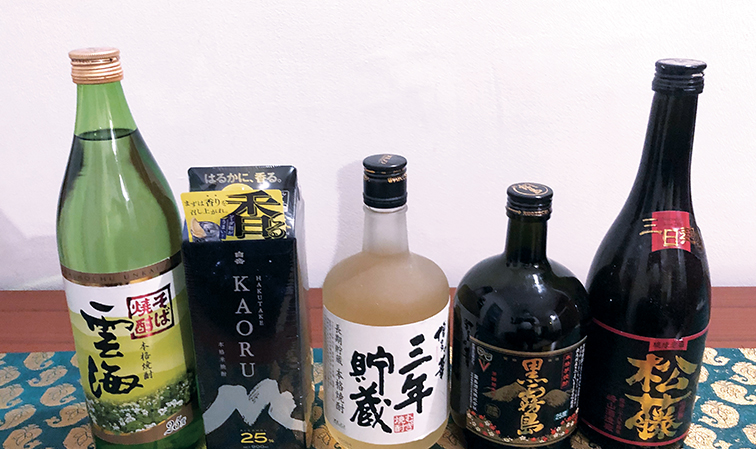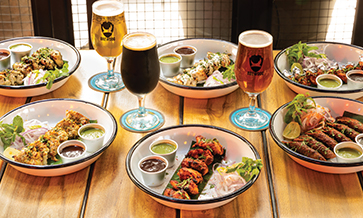According to the Japanese Liquor Tax Law, Shochu is defined as any alcoholic beverage produced by fermenting grains or other substances and distilling the alcohol – with the exception of whiskey, brandy, vodka, rum and gin.
To be more specific, Shochu is alcohol that is not made with sprouted cereals, fruits/ berries, and so on; it is not filtered through birch charcoal; and the alcohol produced during distillation does not leach the surface of other materials.
Sugar and molasses, which are raw materials for rum, are also used in some varieties of Shochu. However, they differ from rum in terms of the production method.
Shochu is thought to have originated in the 15th century when distillation techniques were introduced to Okinawa from the region which is present-day Thailand.
Double-distilled
Shochu can be divided into two main types: Kourui Shochu and Otsurui Shochu. Kourui Shochu is made by fermenting grains, molasses and other ingredients with malted rice or barley. It is distilled twice in succession to a high concentration of alcohol, which is then diluted with water.
Due to the successive fermentation, the flavour of the grains disappears and Kourui Shochu becomes a pure alcoholic drink. It is mainly consumed by mixing it with various drinks or fruit juice.
Kourui Shochu mixed with other drinks or fruit juice is called Ch?hai (Sh?ch? Highball)' or ‘Sour’, which can be enjoyed in some Japanese restaurants in Bengaluru. Kourui Shochu is said to go well with light snacks, and it matches well with tikka.
In Japan, Kourui Shochu is also used to make fruit wine, which is made by adding pickled plums (Ume) or other fruit juices to it.
By contrast, Otsurui Shochu is distilled only once, and is known as ‘Honkaku (authentic) Shochu’ as it is made using traditional methods. The main ingredients here are rice, barley, buckwheat, sweet potato and brown sugar. Rice k?ji and barley k?ji are the main k?ji (malts) used.
Regional variations
By region, Kome Shochu (shochu made from mainly rice) is mainly produced in Kumamoto Prefecture in Kyushu, which is located in western Japan, and Okinawa Prefecture, the southernmost prefecture in Japan.
However, while Kome Shochu produced in Kumamoto Prefecture is made from Japonica rice, Okinawa's shochu, ‘Awamori’, is made from Indica rice. Basmati rice from India is also a type of Indica rice.
Mugi Shochu or barley-based shochu is mainly produced in Fukuoka, Oita, Miyazaki, and a part of Nagasaki prefectures. Soba Shochu, which is made from buckwheat, is produced in cooler areas such as Nagano Prefecture (central Japan), Hokkaido (northern Japan), and a part of Miyazaki Prefecture.
Imo Shochu, which is made mainly from sweet potatoes, is produced in Kagoshima and Miyazaki prefectures in Kyushu, where rice is difficult to grow, and also in the Izu Islands in Tokyo.
Kokuto Shochu, whose main ingredient is brown sugar, is produced mainly in the Amami region of Kagoshima Prefecture, where sugar cane production is thriving. Rum uses only yeast for fermentation, whereas Kokuto Shochu also uses rice malt.
Other varieties of shochu are made from grains and other ingredients, such as potato shochu (different from Imo shochu made from sweet potatoes), which are mainly produced in Hokkaido and Nagasaki prefectures, and Kuri Shochu, made from chestnuts and mainly produced in Ehime and Hyogo prefectures in western Japan, Aichi prefecture in central Japan, and Miyazaki prefecture in Kyushu.
Kasutori Shochu, made from sake lees left over from brewing sake, is produced in many parts of Japan. In addition to the main ingredients, more than 40 sub-ingredients – such as milk, onions, and lotus root – may be added to the shochu, to add flavour and aroma.
Honkaku Shochu retains the flavour of its ingredients, and to enjoy the flavour, it is usually drunk with water, on the rocks, or with hot water, just like whiskey.
Food pairing
The dishes that match with Honkaku Shochu differ according to the variety of Shochu. For instance, Kome shochu is said to go well with fish and light dishes. Imo Shochu has a stronger flavour than other varieties of Shochu, hence it matches well with strongly flavoured dishes and curry.
Mugi Shochu, with its barley flavour, is similar to whiskey and goes well with European food. It is also said to match well with miso-flavoured dishes in Japanese cuisine.
Soba Shochu goes well with fish, meat and spicy dishes. Kokuto Shochu is said to match sweet and spicy-flavoured dishes, as well as vegetable-based dishes. Awamori is said to go well with rich and strongly-flavoured food.














